Performance of a Ship-Based Cupronickel Alloy in Exposure Conditions of Arabian Seawater—A Comparative Study
Abstract
:1. Introduction
2. Experiment and Methods
3. Experimental Results and Discussion
4. Conclusions
- Significantly higher average corrosion rates (ranging between 0.3 and 0.5 mm/y and decreasing with an increase in exposure duration) were observed on coupons exposed to pollutant-rich harbor seawater, whereas the corrosion rates observed in natural seawater conditions were far lower (ranging between 12 and 50 µm/y and decreasing with the exposure duration). The latter were found similar to those reported in the previously published literature for natural seawater conditions.
- The chemical composition of the polluted harbor seawater, primarily due to the higher levels of DINs and sulfur-containing compounds and relatively lower levels of pH and DO, can be the major cause of accelerated corrosion rates and losses.
- After an exposure duration of 150 days, among the experimental coupons, approximately five- to six-times higher average corrosion losses and corrosion rates were observed in the Cu-Ni 90/10 coupons placed in the polluted seawater compared to those in the natural seawater.
- On the basis of the spectroscopic analysis and characterization, these higher corrosion losses may be attributed to the significant role of DINs, sulfur compounds and the chloride content in the polluted harbor seawater site.
- The DM-based corrosion measurement approaches (micrometry and image analyzer) provided localized corrosion loss data of superior quality in the form of a corrosion depth profile, especially in the case of the heat exchanger. The thickness loss data measured using DM-based methods are more realistic and instrumental (than the average mass loss data) in statistical analyses for corrosion prediction modeling and remaining useful life/reliability estimations.
- Spectroscopic techniques provide highly useful data for the characterization of deposits, the elemental composition and the compounds formed on heat exchanger tubes exposed to polluted seawater for a duration of more than ten years. In the EDS graphs and EDS mapping, significantly higher S and Cl levels were observed in the corrosion deposits accumulated on the failed tubes of the heat exchanger exposed to the polluted seawater site.
Author Contributions
Funding
Institutional Review Board Statement
Informed Consent Statement
Data Availability Statement
Acknowledgments
Conflicts of Interest
References
- Abbas, M.; Mahmood, S.; Simms, N. Corrosion Behaviour of Cupronickel 90/10 Alloys in Arabian Sea Conditions and Its Effect on Maintenance of Marine Structures. In Proceedings of the ASME 2019 38th International Conference on Ocean, Offshore and Arctic Engineering, Glasgow, UK, 9–14 June 2019; ASME: Glasgow, UK, 2019; pp. 1–9. [Google Scholar]
- Eiselstein, L.E.; Syrett, B.C.; Wing, S.S.; Caligiuri, R.D. The Accelerated Corrosion of Cu-Ni Alloys in Sulphide-Polluted Seawater: Mechanism No. 2. Corros. Sci. 1983, 23, 223–239. [Google Scholar] [CrossRef]
- Francis, R. Effect of Temperature on the Corrosion of 70/30 Copper-Nickel in Seawater. Br. Corros. J. 1983, 18, 35–39. [Google Scholar] [CrossRef]
- Melchers, R.E. Temperature Effect on Seawater Immersion Corrosion of 90: 10 Copper-Nickel Alloy. Corrosion 2001, 57, 440–451. [Google Scholar] [CrossRef]
- Revie, R.W. Corrosion and Corrosion Control, 4th ed.; John Wiley and Sons Inc.: Hoboken, NJ, USA, 2008; ISBN 978-0-471-73279-2. [Google Scholar]
- Revie, R.W. Uhlig’s Corrosion Handbook, 2nd ed.; John Wiley & Sons Inc.: Hoboken, NJ, USA, 2000; ISBN 0471157775. [Google Scholar]
- Abbas, M.; Simms, N.; Syed, A.S.; Malik, O.A.; Sumner, J. Evaluation of the Effects of Highly Saline and Warm Seawaters on Corrosivity of Marine Assets. In Proceedings of the Eurocorr 2019, Seville, Spain, 9–13 September 2019; European Federation of Corrosion: Saville, Spain, 2019; pp. 1–14. [Google Scholar]
- Melchers, R. Effect of Water Nutrient Pollution on Long-Term Corrosion of 90:10 Copper Nickel Alloy. Materials 2015, 8, 8047–8058. [Google Scholar] [CrossRef]
- Melchers, R. Bi-Modal Trends in the Long-Term Corrosion of Copper and High Copper Alloys. Corros. Sci. 2015, 95, 51–61. [Google Scholar] [CrossRef]
- Besghaier, R.; Dhouibi, L.; Jeannin, M.; Safi, M.J. The Synergetic Effect of Flow Velocity and Exposing Time on the Electrochemical Behavior of Cu–Ni 90/10 Alloy in Simulating Conditions of Desalination Plant. Chem. Afr. 2019, 2, 483–495. [Google Scholar] [CrossRef]
- Ekerenam, O.O.; Ma, A.L.; Zheng, Y.G.; He, S.Y.; Okafor, P.C. Evolution of the Corrosion Product Film and Its Effect on the Erosion–Corrosion Behavior of Two Commercial 90Cu–10Ni Tubes in Seawater. Acta Metall. Sin. (Engl. Lett.) 2018, 31, 1148–1170. [Google Scholar] [CrossRef]
- Melchers, R. Influence of Dissolved Inorganic Nitrogen on Accelerated Low Water Corrosion of Marine Steel Piling. Corrosion 2013, 69, 95–103. [Google Scholar] [CrossRef]
- Grolleau, A.-M.; Guyader, L.E.; Pautasso, J.-P. Corrosion Properties of Copper Nickel Alloys in Chlorinated Sea Water. In Proceedings of the Eurocorr 2011, Stockholm, Sweden, 4–8 September 2011. [Google Scholar]
- Agarwal, D.C.; Bapat, A.M. Effect of Ammonia and Sulphide Environment on 90/10 and 70/30 Cupronickel Alloy. J. Fail. Anal. Prev. 2009, 9, 444–460. [Google Scholar] [CrossRef]
- Schleich, W. Typical Failures of CuNi 90/10 Seawater Tubing Systems and How to Avoid Them. In Proceedings of the Eurocorr 2004, Nice, France, 12–16 September 2004; p. 10. [Google Scholar]
- Syrett, B. The Mechanism of Accelerated Corrosion of Copper-Nickel Alloys in Sulphide-Polluted Seawater. Corros. Sci. 1981, 21, 187–209. [Google Scholar] [CrossRef]
- Schleich, K.M.W.; Powell, C. CuNi 90/10: How to Avoid Typical Failures of Seawater Tubing Systems and Marine Biofouling on Structures. In Corrosion Behaviour and Protection of Copper and Aluminium Alloys in Seawater; Feron, D., Ed.; Woodhead publishing limited: Cambridge, UK, 2007; pp. 73–94. ISBN 9781845692414. [Google Scholar]
- Sun, B.; Ye, T.; Feng, Q.; Yao, J.; Wei, M. Accelerated Degradation Test and Predictive Failure Analysis of B10 Copper-Nickel Alloy under Marine Environmental Conditions. Materials 2015, 8, 6029–6042. [Google Scholar] [CrossRef] [PubMed]
- Nicklin, G.J.E. Living with the Threat of Microbiologically Influenced Corrosion in Submarine Seawater Systems: The Royal Navy’s Perspective. Conf. Proc. Inst. Mar. Eng. Sci. Technol. 2008. [Google Scholar]
- Chandra, K.; Mahanti, A.; Singh, A.P.; Kain, V.; Gujar, H.G. Microbiologically Influenced Corrosion of 70/30 Cupronickel Tubes of a Heat-Exchanger. Eng. Fail. Anal. 2019, 105, 1328–1339. [Google Scholar] [CrossRef]
- Melchers, R. Progress in Developing Realistic Corrosion Models. Struct. Infrastruct. Eng. 2018, 14, 843–853. [Google Scholar] [CrossRef]
- Melchers, R.; Jeffrey, R.J. Long-Term Corrosion of Mild Steel in Natural and Uv-Treated Coastal Seawater. Corrosion 2014, 70, 804–818. [Google Scholar] [CrossRef] [PubMed]
- Melchers, R.E.; Herron, C.; Emslie, R. Long Term Marine Corrosion of Cast Iron Bridge Piers Long Term Marine Corrosion of Cast Iron Bridge Piers. Corros. Eng. Sci. Technol. 2016, 51, 248–255. [Google Scholar] [CrossRef]
- Phull, B.S.; Pikul, S.J.; Kain, R.M. Seawater Corrosivity around the World: Results from Five Years of Testing. In Corrosion Testing in Natural Waters; Kian, R.M., T.Young, W., Eds.; ASTM International: Norfolk, VA, USA, 1997; Volume 2, pp. 34–73. [Google Scholar]
- County, V. City of Port Hueneme Consumer Confidence; City of Port Hueneme: Port Hueneme, CA, USA, 2016. [Google Scholar]
- Reinhart, F.M.; Jenkins, J.F. Corrosion of Materials in Surface Seawater after 12 and 18 Months of Exposure; US Naval Civil Engineering Laboratory: Port Hueneme, CA, USA, 1972. [Google Scholar]
- NBVC Annual Water Quality Report; Port Huneme Water Agency: Port Huneme, CA, USA, 2017.
- Cui, Y.; Hu, S.; Liu, L.; Wang, F.; Li, Y. Influence of Hydrostatic Pressure on the Corrosion Behavior of 90/10 Copper-Nickel Alloy Tube under Alternating Dry and Wet Condition. Corros. Sci. 2018, 146, 202–212. [Google Scholar] [CrossRef]
- Lopesino, P.; Alcántara, J.; de la Fuente, D.; Chico, B.; Jiménez, J.A.; Morcillo, M. Corrosion of Copper in Unpolluted Chloride-Rich Atmospheres. Metals 2018, 8, 866. [Google Scholar] [CrossRef]
- Helena, S.; Johansson, L.-G. Some Aspects of the Atmospheric Corrosion of Copper in the Presence of Sodium Chloride. J. Electrochem. Soc. 1998, 145, 1093–1100. [Google Scholar] [CrossRef]
- Frost, R.L. Raman Spectroscopy of Selected Copper Minerals of Significance in Corrosion. Spectrochim. Acta-Part A Mol. Biomol. Spectrosc. 2003, 59, 1195–1204. [Google Scholar] [CrossRef]
- Jin, T.; Zhang, W.; Li, N.; Liu, X.; Han, L.; Dai, W. Surface Characterization and Corrosion Behavior of 90/10 Copper-Nickel Alloy in Marine Environment. Materials 2019, 12, 1869. [Google Scholar] [CrossRef] [PubMed]
- Hill, M. Copper Patinas Formed in the Atmosphere--II. a Qualitative Assessment of Mechanisms. Corros. Sci. 1987, 27, 721–740. [Google Scholar]
- Ma, A.L.; Jiang, S.L.; Zheng, Y.G.; Ke, W. Corrosion Product Film Formed on the 90/10 Copper-Nickel Tube in Natural Seawater: Composition/Structure and Formation Mechanism. Corros. Sci. 2015, 91, 245–261. [Google Scholar] [CrossRef]
- Pollard, A.M.; Thomas, R.G.; Williams, P.A. Synthesis and Stabilities of the Basic Copper(II) Chlorides Atacamite, Paratacamite and Botallackite. Mineral. Mag. 1989, 53, 557–563. [Google Scholar] [CrossRef]
- Abbas, M.; Simms, N.; Lao, L.; Malik, O.A.; Syed, A.U.; Ali Sarfraz, S.; Ashraf, L.; Rizvi, S.H.M. A Dimensional Metrology-Based Approach for Corrosion Measurement of Ship Grade Steels Exposed to Various Marine Environmental Conditions. Corros. Eng. Sci. Technol. 2021, 56, 448–460. [Google Scholar] [CrossRef]
- Simms, N.J.; Oakey, J.E.; Nicholls, J.R. Development and Application of a Methodology for the Measurement of Corrosion and Erosion Damage in Laboratory, Burner Rig and Plant Environments. Mater. High Temp. 2000, 17, 355–362. [Google Scholar] [CrossRef]
- ASTM G1-03; Standard Practice for Preparing, Cleaning, and Evaluating Corrosion Test. ASTM International: West Conshohocken, PA, USA, 2017; pp. 1–9.
- ASTM G52-20; ASTM Standard Practice for Exposing and Evaluating Metals and Alloys in Surface. ASTM International: West Conshohocken, PA, USA, 2016.
- Ahmad, Z.; Aleem, B.J.A. The Corrosion Performance of 90-10 Cupronickel in Arabian Gulf Water Containing Ammonia. Desalination 1994, 95, 307–323. [Google Scholar] [CrossRef]
- Ali Sarfraz, S.; Abbas, M.; Sarfraz, S.; Ashraf, F. Performance Evaluation of Cu-Ni 90/10 Alloyed Structures Exposed to Various Seawater Compositions and Their Remaining Service Life Estimation. In Proceedings of the 11th International Conference on Through-Life Engineering Services–TESConf2022, Cranfield, UK, 8–9 November 2022. [Google Scholar]
- Schleich, W. Application of Copper-Nickel Alloy UNS C70600 for Seawater Service. In Proceedings of the Corrosion 2005, Houston, TX, USA, 3–7 April 2005; pp. 1–14. [Google Scholar]
- Chan, H.Y.H.; Takoudis, C.G.; Weaver, M.J. Oxide Film Formation and Oxygen Adsorption on Copper in Aqueous Media as Probed by Surface-Enhanced Raman Spectroscopy. J. Phys. Chem. B 1999, 103, 357–365. [Google Scholar] [CrossRef]
- Liu, M.; Li, J. In-Situ Raman Characterization of Initial Corrosion Behavior of Copper in Neutral 3.5% (Wt.) NaCl Solution. Materials 2019, 12, 2164. [Google Scholar] [CrossRef]
- Frost, R.L.; Martens, W.; Theo Kloprogge, J.; Williams, P.A. Raman Spectroscopy of the Basic Copper Chloride Minerals Atacamite and Paratacamite: Implications for the Study of Copper, Brass and Bronze Objects of Archaeological Significance. J. Raman Spectrosc. 2002, 33, 801–806. [Google Scholar] [CrossRef]
- Deng, Y.; Handoko, A.D.; Du, Y.; Xi, S.; Yeo, B.S. In Situ Raman Spectroscopy of Copper and Copper Oxide Surfaces during Electrochemical Oxygen Evolution Reaction: Identification of Cu Oxides as Catalytically Active Species. ACS Catal. 2016, 6, 2473–2481. [Google Scholar] [CrossRef]
- Bindi, L.; Christy, A.G.; Mills, S.J.; Ciriotti, M.E.; Bittarello, E. New Compositional and Structural Data Validate the Status of Jamborite. Can. Mineral. 2016, 53, 791–802. [Google Scholar] [CrossRef]


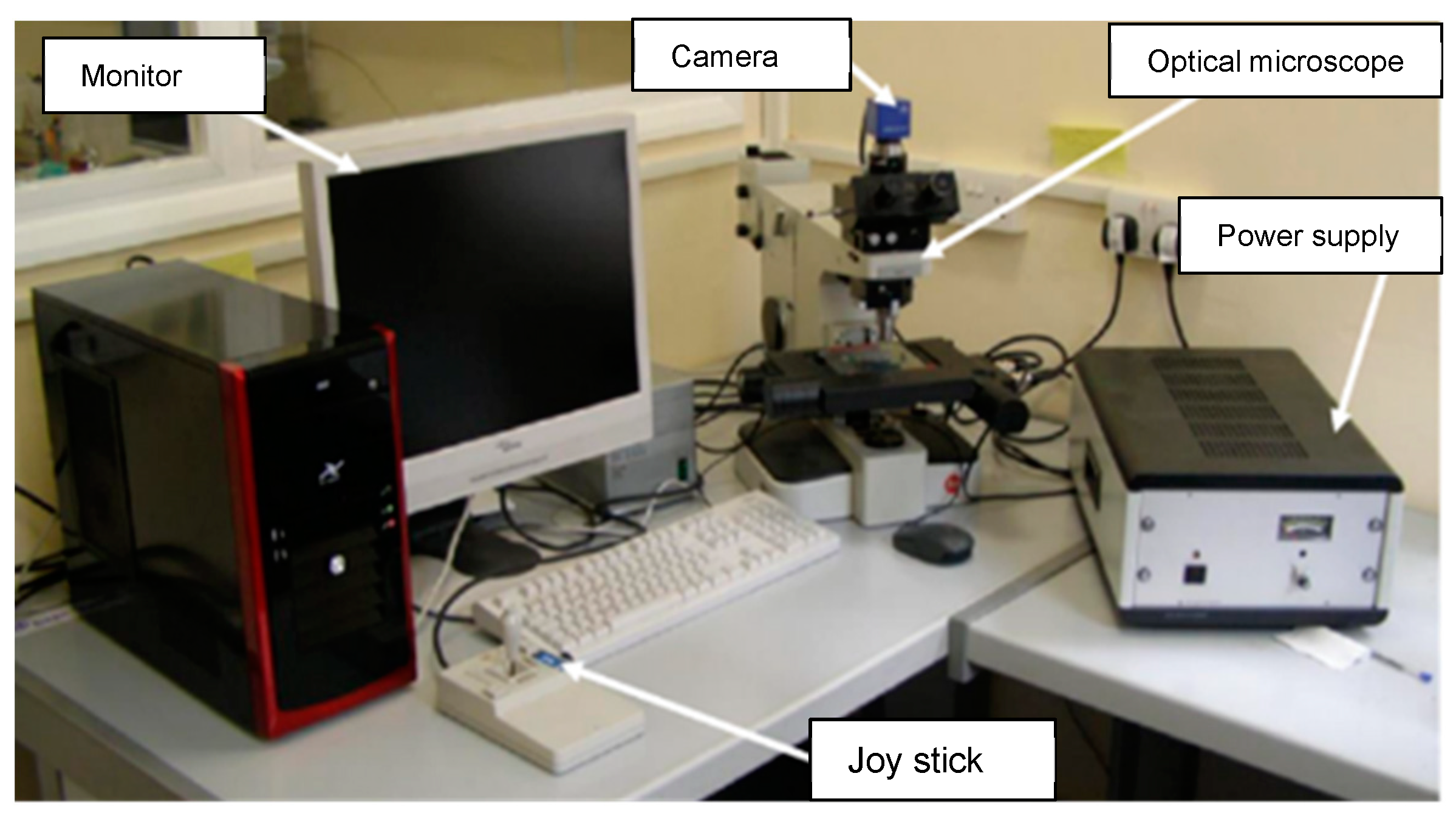
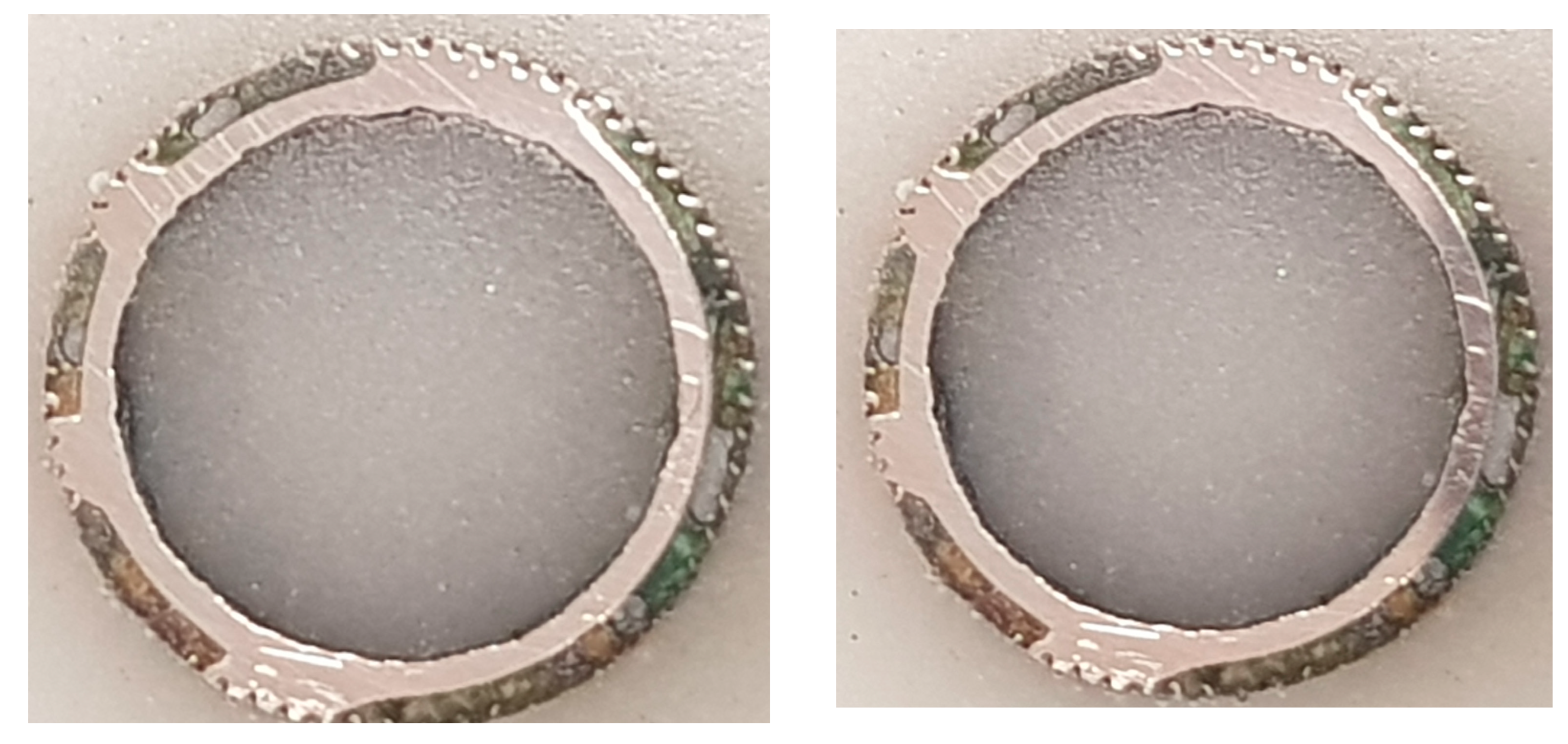

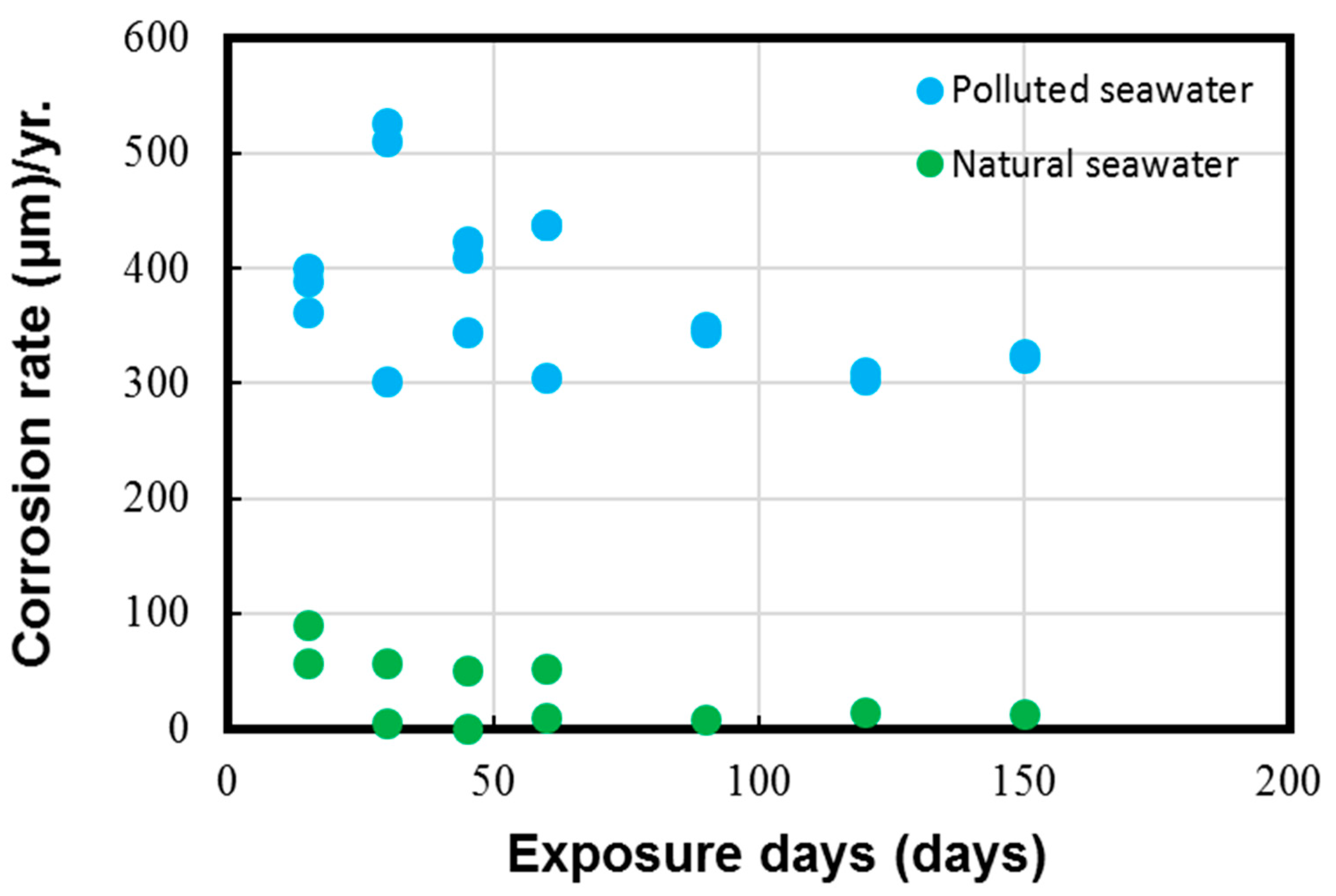

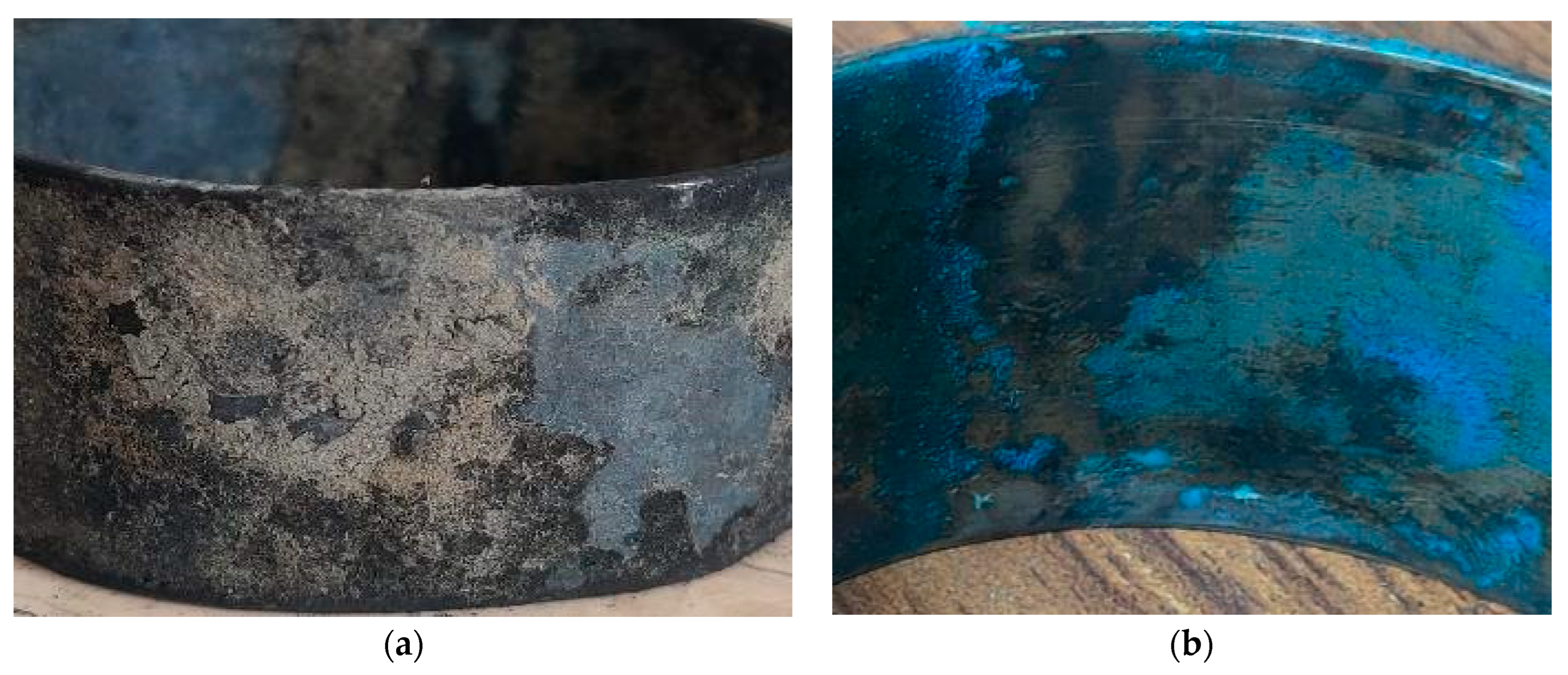
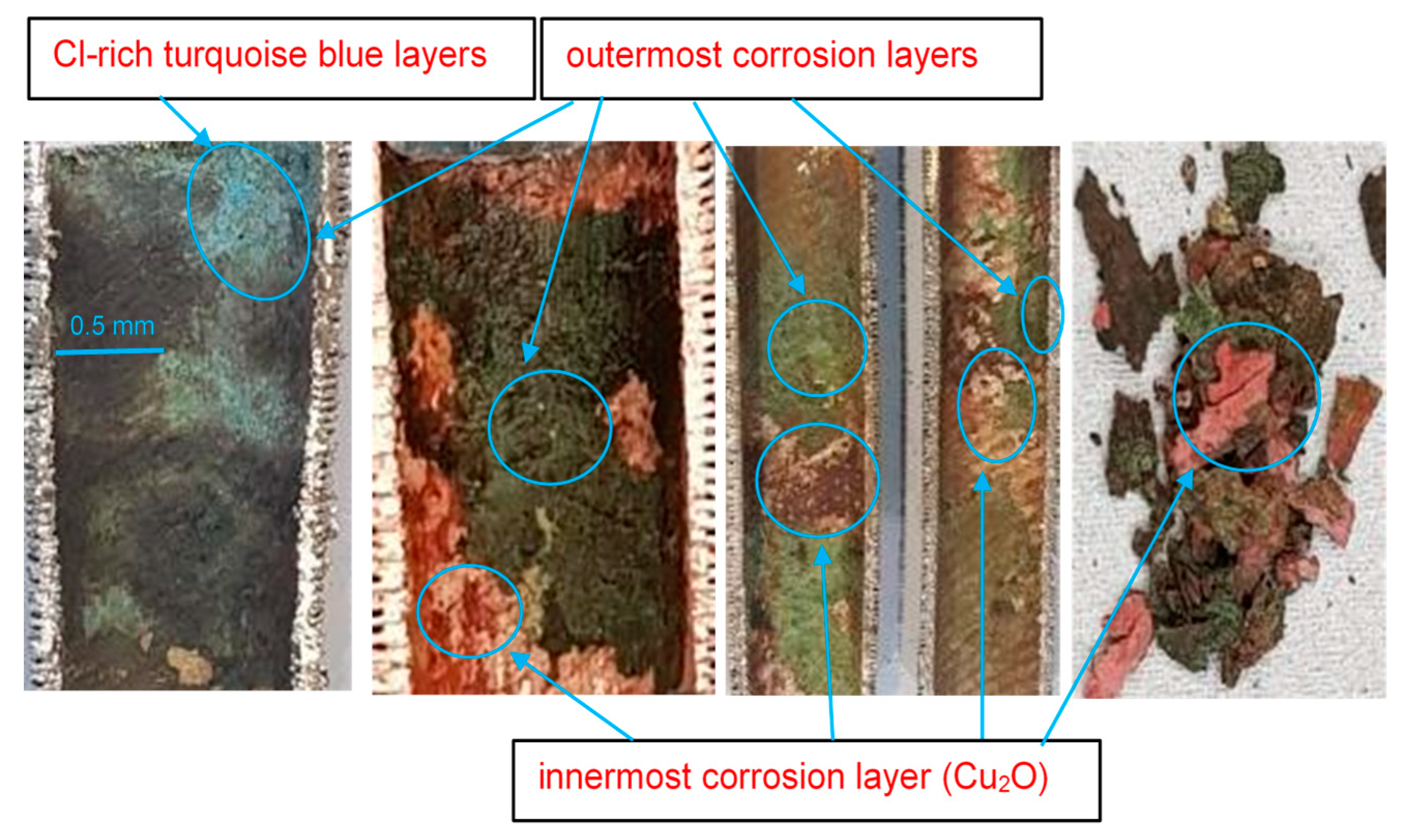
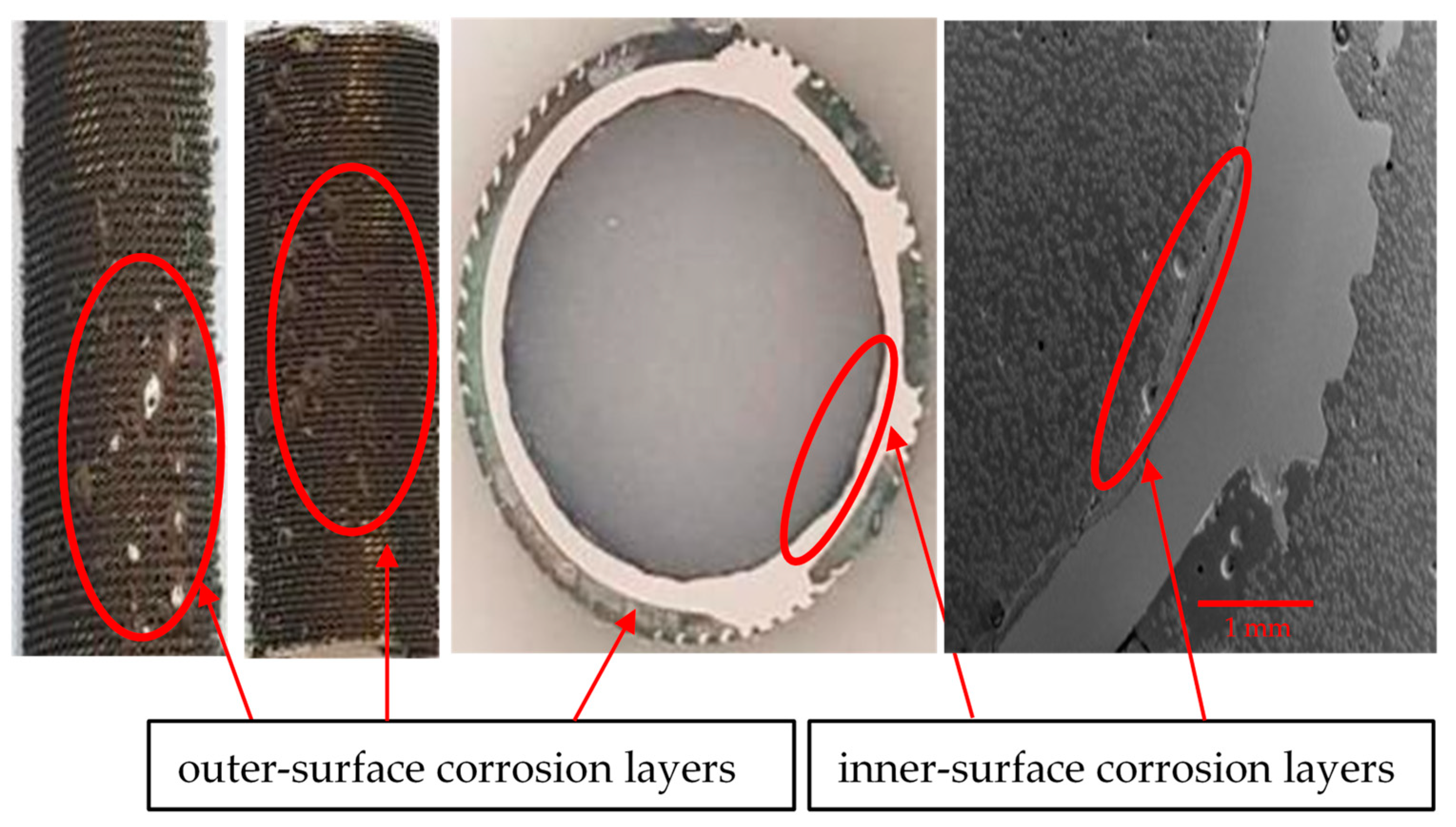
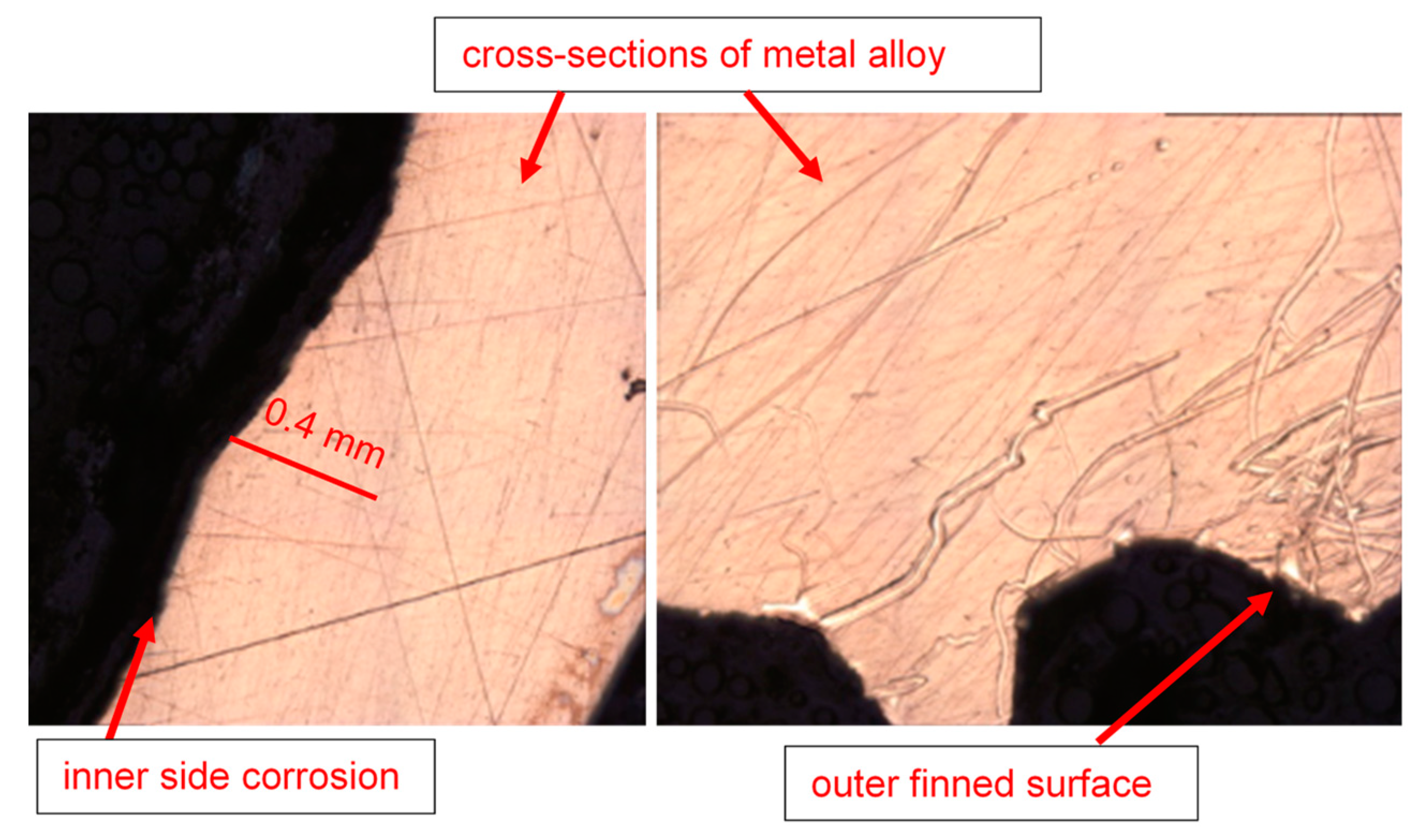
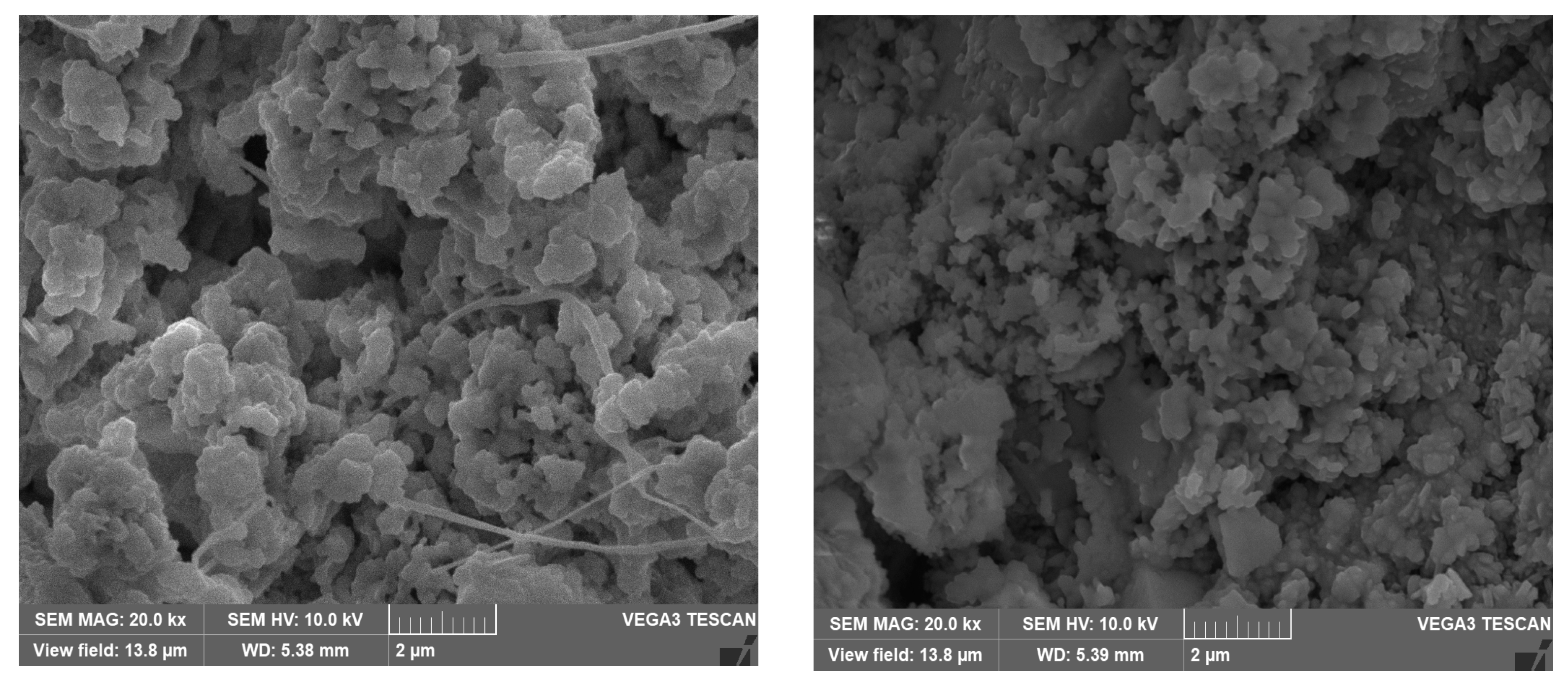
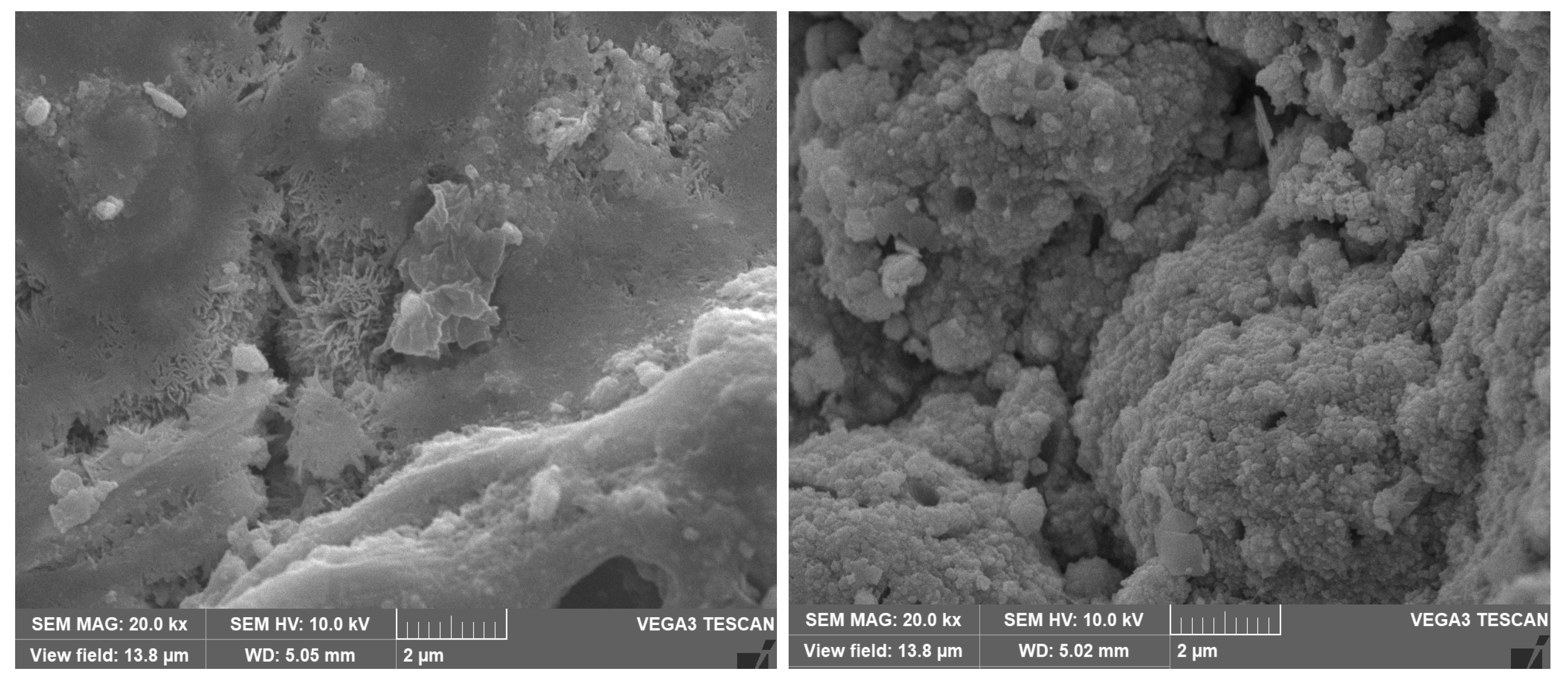

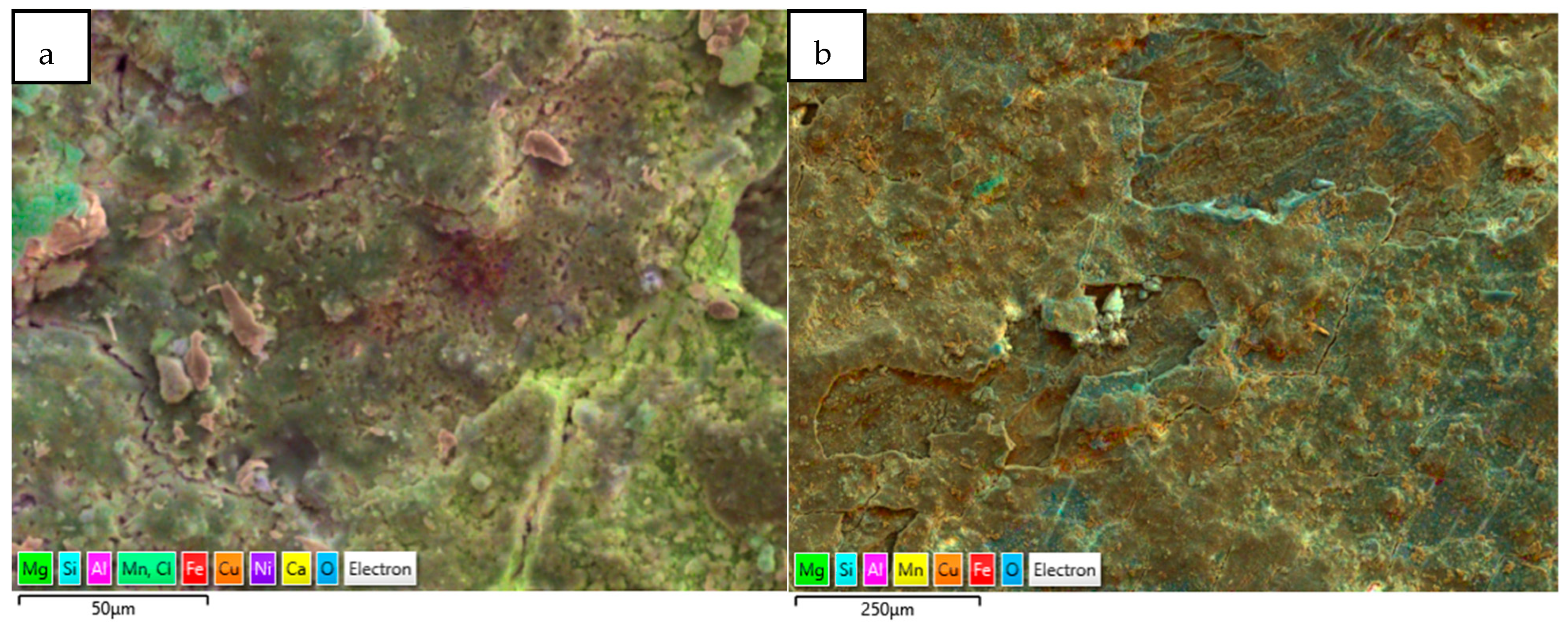
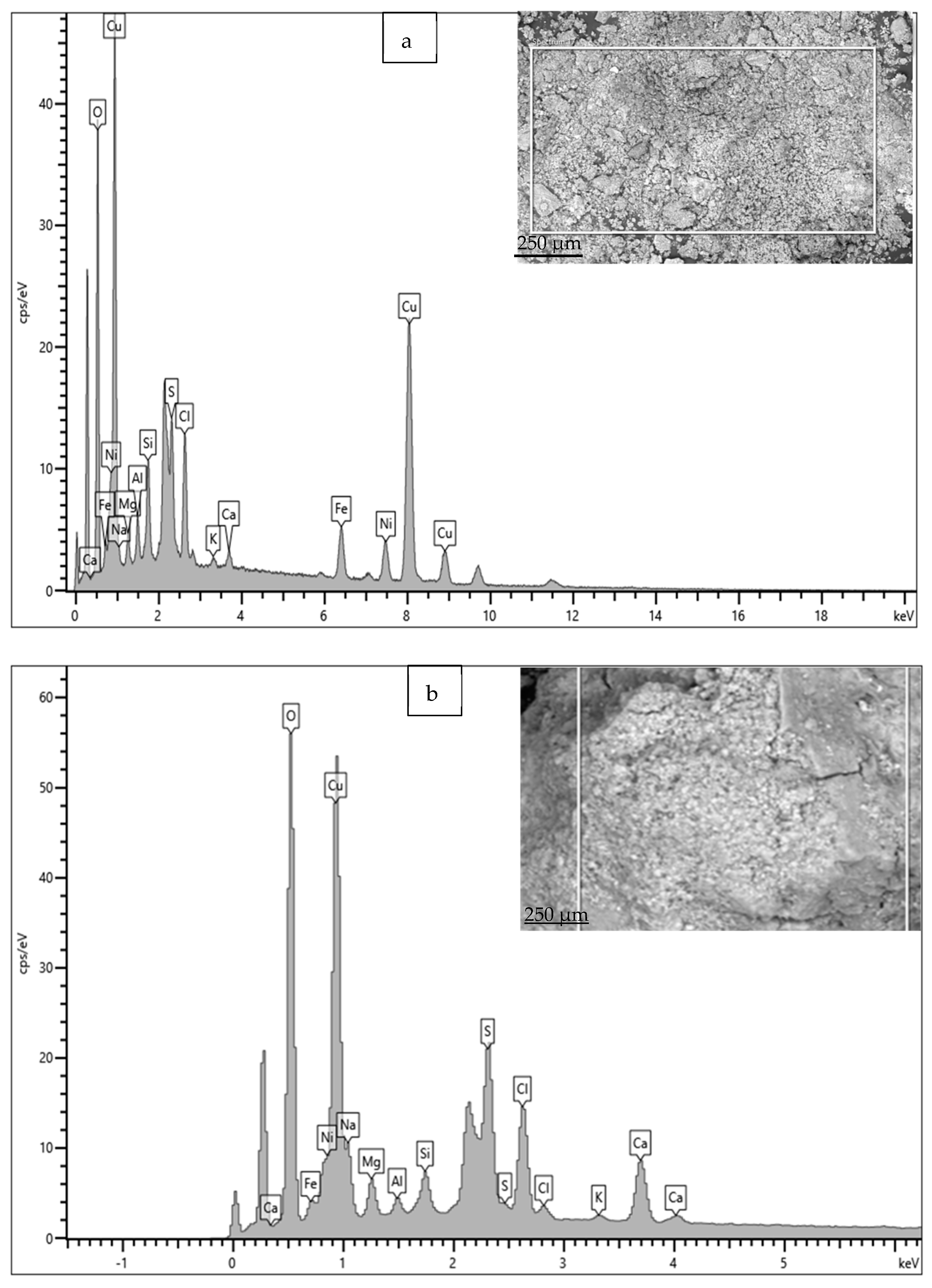
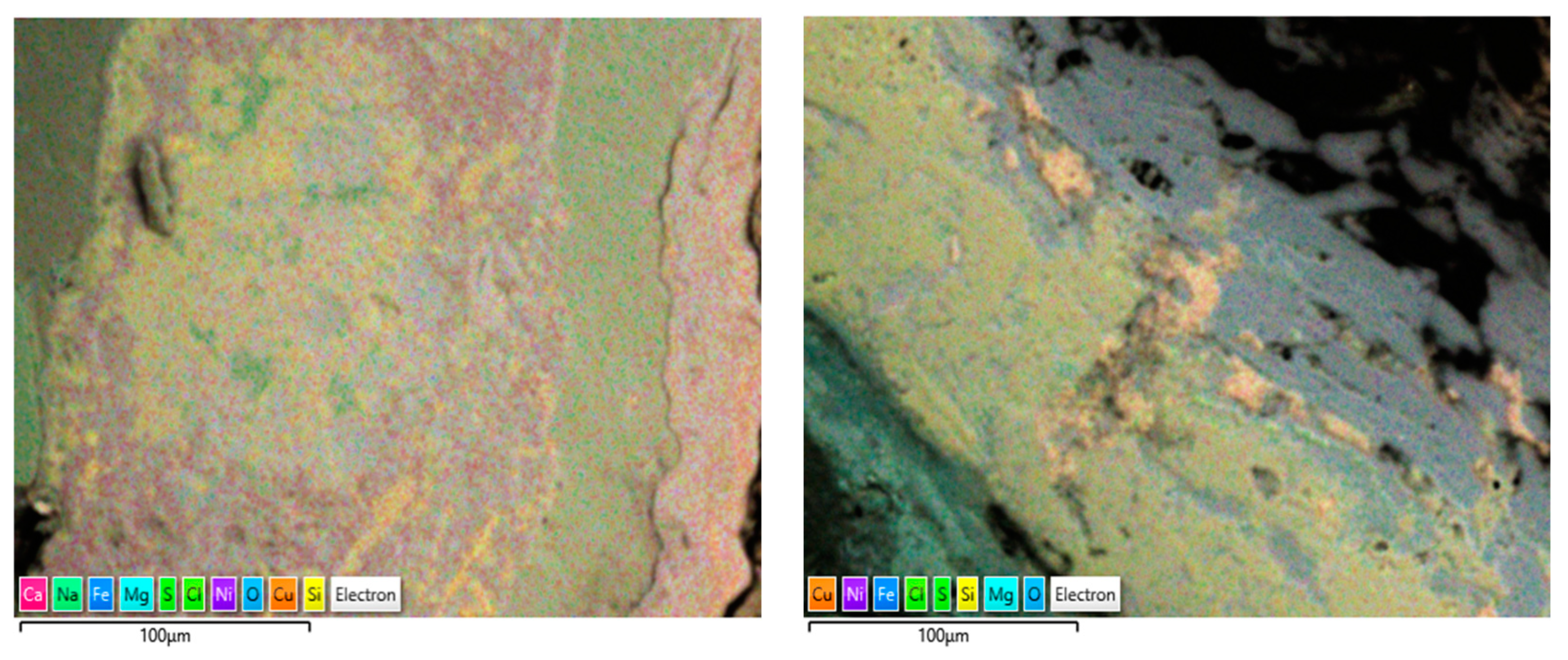
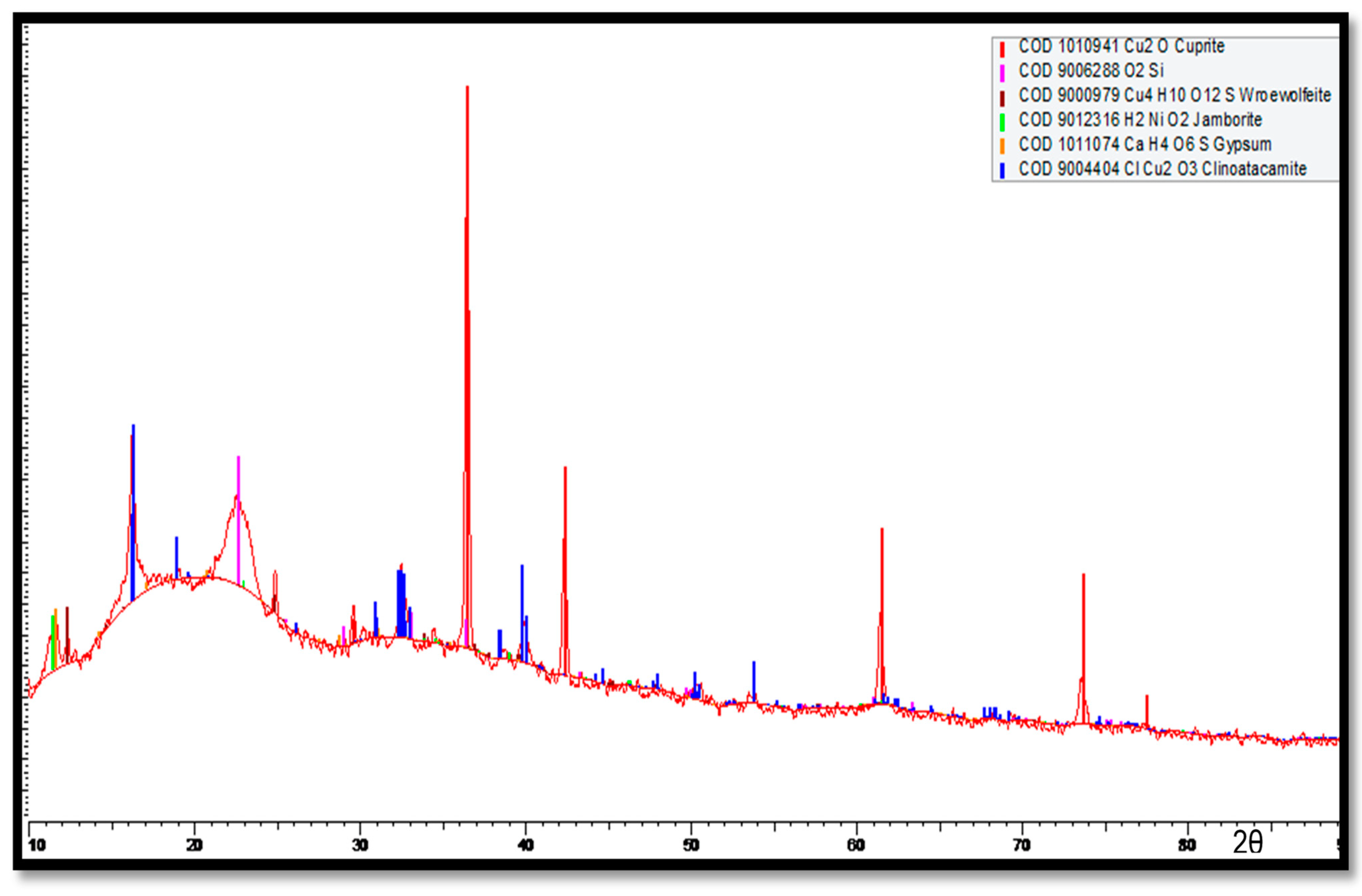
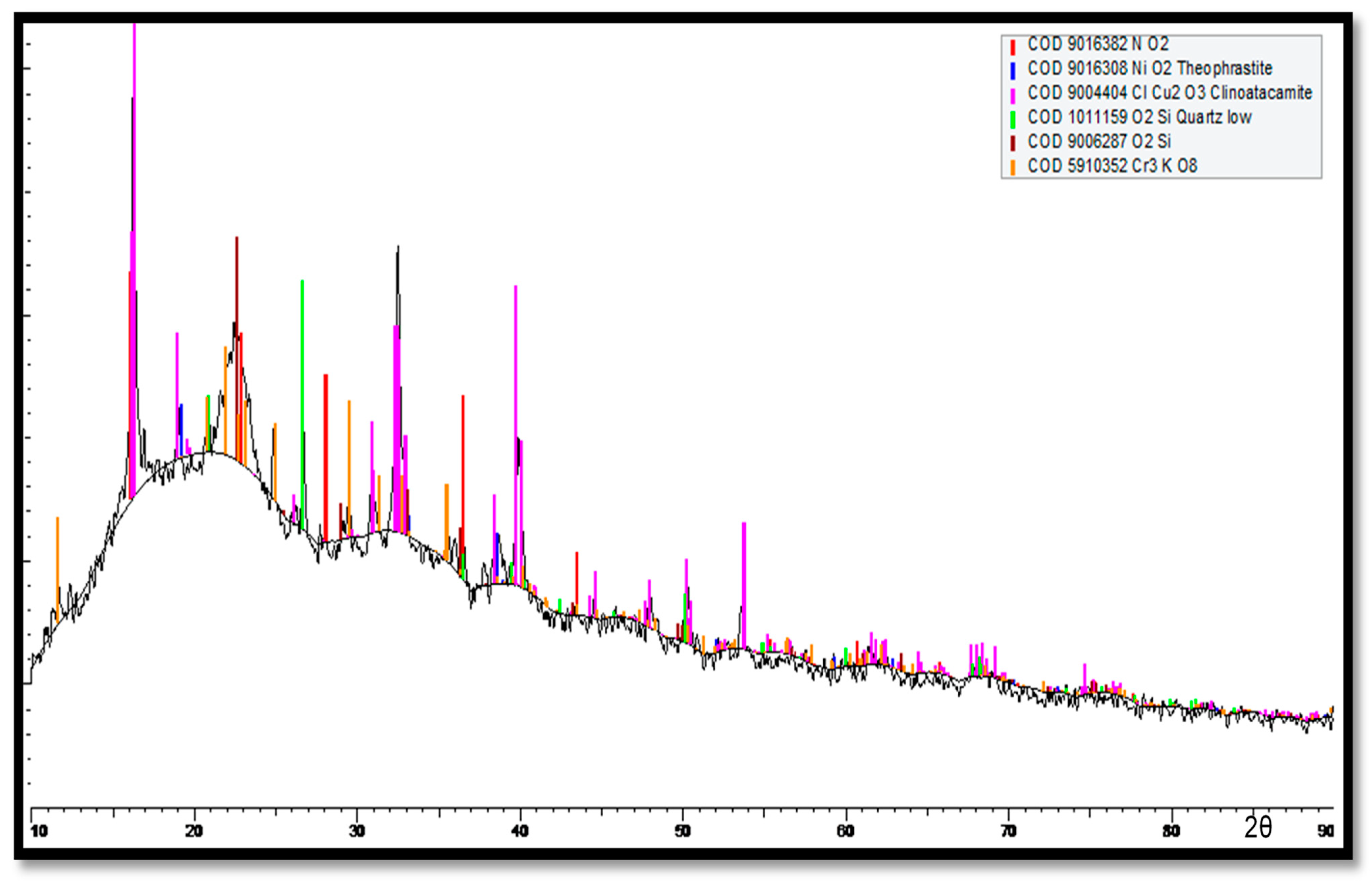
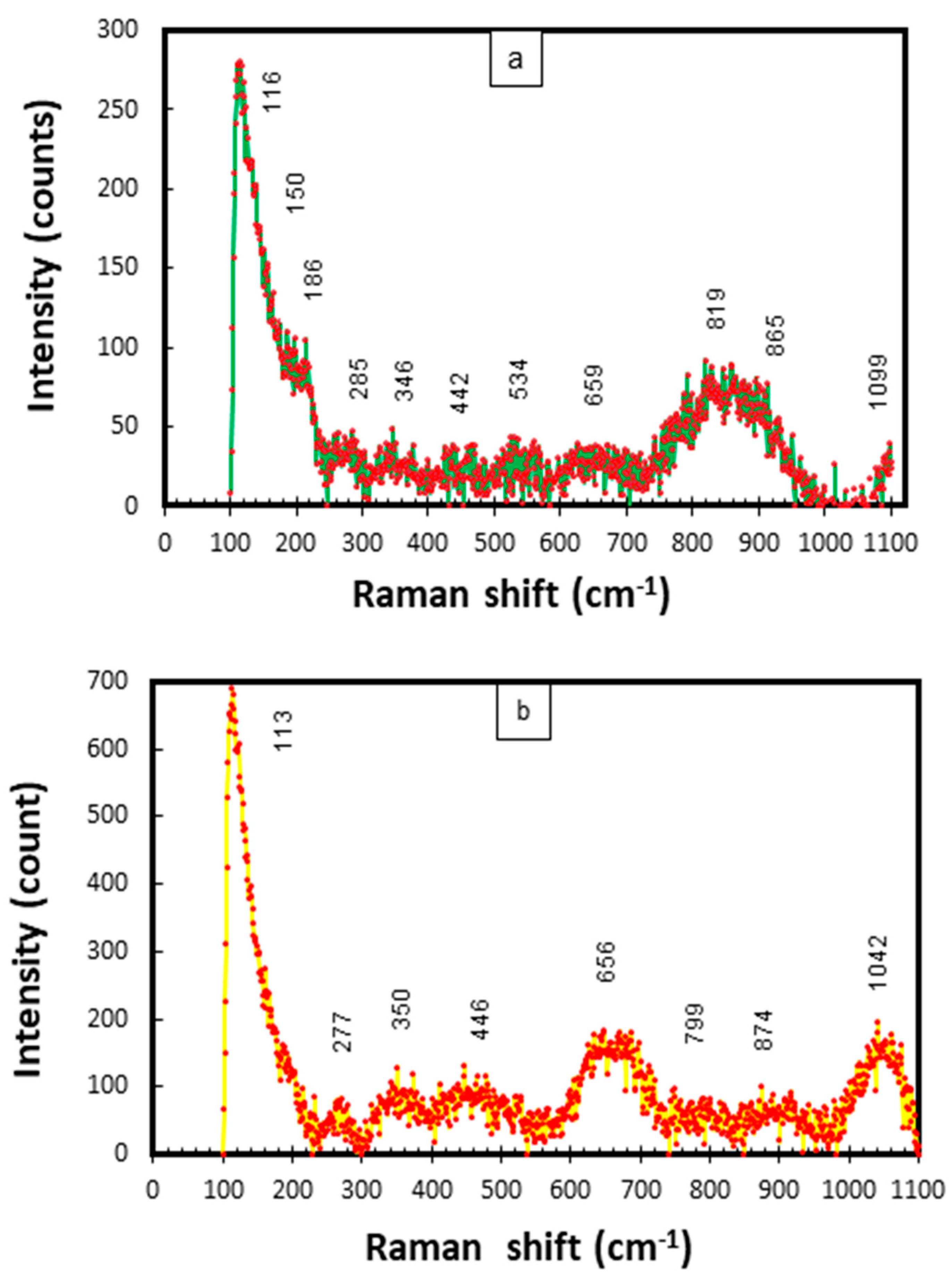
| Cu | Ni | Fe | Mn | Al | Si |
|---|---|---|---|---|---|
| R | 9.95 | 1.14 | 0.88 | 0.13 | <0.09 |
| Parameters | Natural Seawater | Polluted Seawater |
|---|---|---|
| Temperature (°C) | 25–30 | 25–30 |
| pH Level | 7.5–8.2 | 6.9–7.4 |
| DO (mg/L) | >3.5 | 0.63 ± 0.39 |
| EC (mS/m) | 50 | 63 ± 4.8 |
| Nitrates (mg/L) | <0.1 | 1.2 ± 0.3 |
| Chloride (mg/L) | 18,000 ± 500 | 21,000 ± 1000 |
| Sulfate (ppm) | 1900 | 2900 |
| O | Na | Mg | Al | Si | S | Cl | K | Ca | Fe | Ni | Cu |
|---|---|---|---|---|---|---|---|---|---|---|---|
| 41.9 | 3.3 | 1.8 | 2.3 | 4.8 | 3.3 | 2 | 0.6 | 0.9 | 5.8 | 2.9 | 30.1 |
| 40.5 | 2.9 | 1.7 | 0.5 | 1.0 | 4.8 | 3.3 | 0.2 | 2.17 | 2.9 | 1.8 | 38.1 |
Disclaimer/Publisher’s Note: The statements, opinions and data contained in all publications are solely those of the individual author(s) and contributor(s) and not of MDPI and/or the editor(s). MDPI and/or the editor(s) disclaim responsibility for any injury to people or property resulting from any ideas, methods, instructions or products referred to in the content. |
© 2024 by the authors. Licensee MDPI, Basel, Switzerland. This article is an open access article distributed under the terms and conditions of the Creative Commons Attribution (CC BY) license (https://creativecommons.org/licenses/by/4.0/).
Share and Cite
Sarfraz, S.A.; Abbas, M.; Ahmad, N.M. Performance of a Ship-Based Cupronickel Alloy in Exposure Conditions of Arabian Seawater—A Comparative Study. Materials 2024, 17, 3940. https://doi.org/10.3390/ma17163940
Sarfraz SA, Abbas M, Ahmad NM. Performance of a Ship-Based Cupronickel Alloy in Exposure Conditions of Arabian Seawater—A Comparative Study. Materials. 2024; 17(16):3940. https://doi.org/10.3390/ma17163940
Chicago/Turabian StyleSarfraz, Syed Ali, Muntazir Abbas, and Nasir Mahmood Ahmad. 2024. "Performance of a Ship-Based Cupronickel Alloy in Exposure Conditions of Arabian Seawater—A Comparative Study" Materials 17, no. 16: 3940. https://doi.org/10.3390/ma17163940





